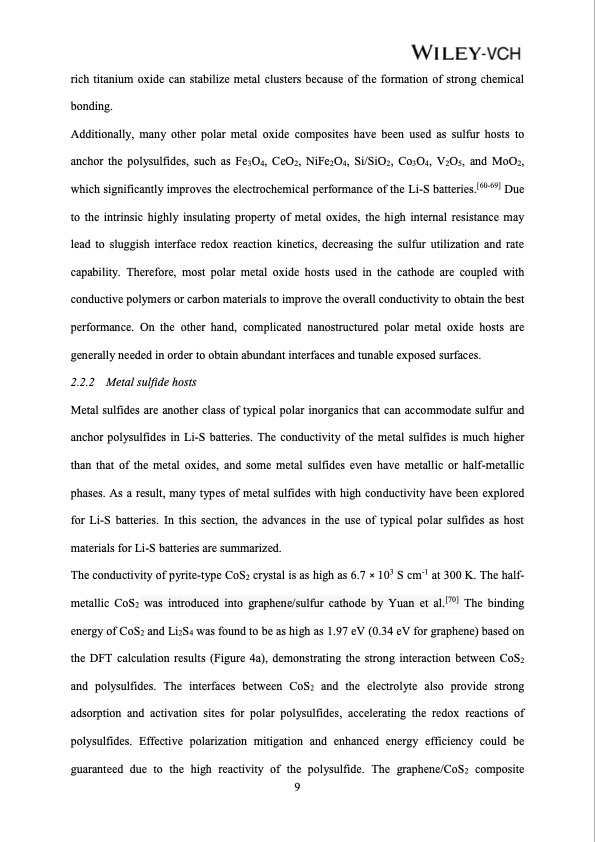
PDF Publication Title:
Text from PDF Page: 011
rich titanium oxide can stabilize metal clusters because of the formation of strong chemical bonding. Additionally, many other polar metal oxide composites have been used as sulfur hosts to anchor the polysulfides, such as Fe3O4, CeO2, NiFe2O4, Si/SiO2, Co3O4, V2O5, and MoO2, which significantly improves the electrochemical performance of the Li-S batteries.[60-69] Due to the intrinsic highly insulating property of metal oxides, the high internal resistance may lead to sluggish interface redox reaction kinetics, decreasing the sulfur utilization and rate capability. Therefore, most polar metal oxide hosts used in the cathode are coupled with conductive polymers or carbon materials to improve the overall conductivity to obtain the best performance. On the other hand, complicated nanostructured polar metal oxide hosts are generally needed in order to obtain abundant interfaces and tunable exposed surfaces. 2.2.2 Metal sulfide hosts Metal sulfides are another class of typical polar inorganics that can accommodate sulfur and anchor polysulfides in Li-S batteries. The conductivity of the metal sulfides is much higher than that of the metal oxides, and some metal sulfides even have metallic or half-metallic phases. As a result, many types of metal sulfides with high conductivity have been explored for Li-S batteries. In this section, the advances in the use of typical polar sulfides as host materials for Li-S batteries are summarized. The conductivity of pyrite-type CoS2 crystal is as high as 6.7 × 103 S cm-1 at 300 K. The half- metallic CoS2 was introduced into graphene/sulfur cathode by Yuan et al.[70] The binding energy of CoS2 and Li2S4 was found to be as high as 1.97 eV (0.34 eV for graphene) based on the DFT calculation results (Figure 4a), demonstrating the strong interaction between CoS2 and polysulfides. The interfaces between CoS2 and the electrolyte also provide strong adsorption and activation sites for polar polysulfides, accelerating the redox reactions of polysulfides. Effective polarization mitigation and enhanced energy efficiency could be guaranteed due to the high reactivity of the polysulfide. The graphene/CoS2 composite 9PDF Image | Advances in Polar Materials for Lithium-Sulfur Batteries

PDF Search Title:
Advances in Polar Materials for Lithium-Sulfur BatteriesOriginal File Name Searched:
212718644.pdfDIY PDF Search: Google It | Yahoo | Bing
Sulfur Deposition on Carbon Nanofibers using Supercritical CO2 Sulfur Deposition on Carbon Nanofibers using Supercritical CO2. Gamma sulfur also known as mother of pearl sulfur and nacreous sulfur... More Info
CO2 Organic Rankine Cycle Experimenter Platform The supercritical CO2 phase change system is both a heat pump and organic rankine cycle which can be used for those purposes and as a supercritical extractor for advanced subcritical and supercritical extraction technology. Uses include producing nanoparticles, precious metal CO2 extraction, lithium battery recycling, and other applications... More Info
| CONTACT TEL: 608-238-6001 Email: greg@infinityturbine.com | RSS | AMP |